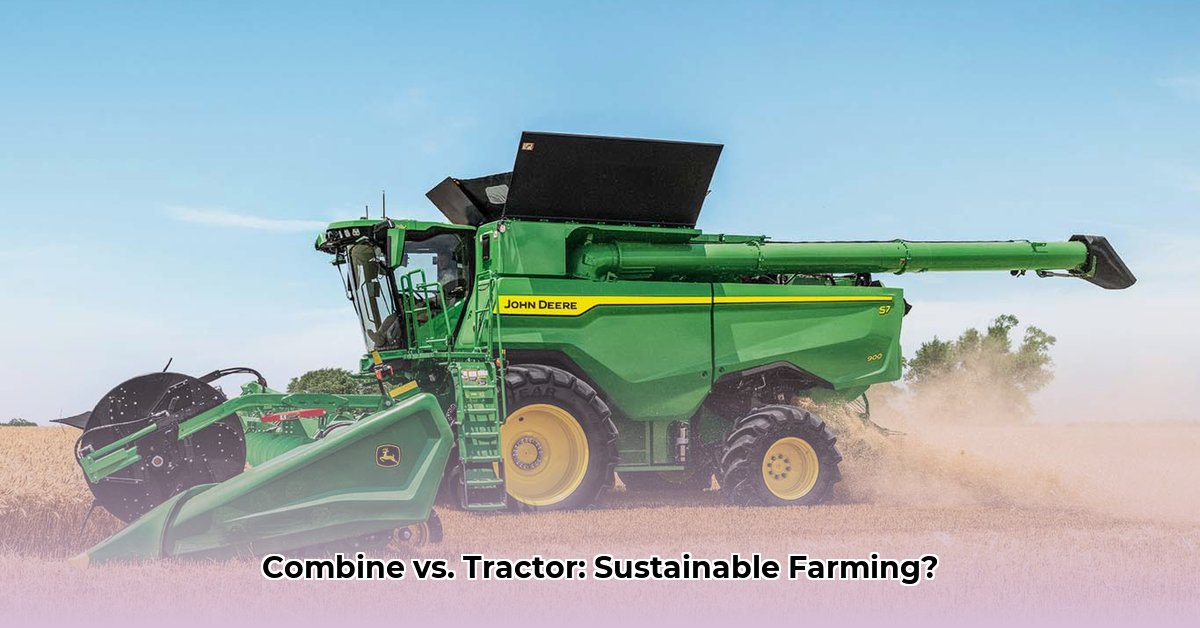
Understanding Combines and Tractors in Sustainable Agriculture
A combine harvester and a tractor are distinct agricultural machines, each playing a crucial, yet different, role in sustainable farming practices. The key difference lies in their specialization: a tractor is a versatile platform, while a combine is highly specialized for grain harvesting. Choosing the right equipment depends heavily on farm size, crop diversity, and budgetary considerations. This comparative analysis will equip you to make informed decisions that optimize both yield and environmental sustainability. For more information on tractor options, check out this resource.
The Tractor: A Versatile Workhorse
Tractors are the backbone of most agricultural operations, renowned for their adaptability. Their versatility stems from their ability to utilize a wide array of attachments, transforming them into tools for plowing, planting, spraying, and various other tasks throughout the growing season. This adaptability is a cornerstone of sustainable farming, enabling precise planting, targeted fertilizer application, and optimized resource utilization, ultimately minimizing waste and environmental impact. However, tractors lack the specialized harvesting capabilities of combines.
The Combine Harvester: Grain Harvesting Efficiency
Combine harvesters are specialized machines designed exclusively for harvesting grain crops such as wheat, corn, and soybeans. These machines simultaneously cut, thresh (separate grain from stalks), clean, and store harvested grains in one continuous operation. This high degree of automation significantly reduces labor requirements, leading to increased efficiency and reduced harvest time. This efficiency translates directly to minimizing post-harvest losses and optimizing resource utilization during the critical harvest period.
Comparative Analysis: Combines vs. Tractors for Sustainable Farming
The following table directly compares combines and tractors, highlighting their respective contributions to sustainable agriculture:
| Feature | Combine Harvester | Tractor |
|---|---|---|
| Primary Function | Grain harvesting | Diverse field operations |
| Efficiency | High for grain harvesting; low for other tasks | Varies widely depending on the attached implement |
| Labor Requirements | Significantly reduced during harvesting | Dependent on the task; often higher than combines |
| Resource Use | Optimized for grain harvesting; potential for high fuel consumption | Variable; potential for efficiency gains with precision technologies |
| Initial Cost | High | Lower |
| Sustainability Impact | Reduces post-harvest losses; increases efficiency | Supports various sustainable practices; efficiency depends on management |
Choosing the Right Equipment: A Sustainable Approach
The decision between a combine and a tractor, or both, hinges on your farm's specific context:
Farm Scale: Large-scale grain farms will likely benefit most from the efficiency of a combine harvester. Smaller farms or those with diverse crop types may find a tractor with various attachments to be more cost-effective.
Crop Diversity: Farms cultivating a variety of crops will find the tractor's versatility indispensable. A combine will only be truly valuable if grain crops are a significant portion of the agricultural operation.
Economic Sustainability: The initial investment for a combine is substantially higher. However, this investment may result in significant cost savings over time due to increased harvesting efficiency and reduced labor costs.
Actionable Steps for Sustainable Equipment Selection
- Assess your farm's needs: Carefully evaluate your farm size, crop types, labor availability, and budget.
- Analyze your budget: Determine the upfront and operational costs associated with each type of equipment. Consider shared equipment arrangements or renting as alternatives for smaller operations.
- Prioritize fuel efficiency: Invest in newer models with advanced fuel-saving technologies to minimize your environmental impact and operational costs.
- Evaluate environmental impact: Consider the overall life-cycle environmental impact, including manufacturing, operation, and disposal. Choose equipment and practices that minimize greenhouse gas emissions and reduce waste.
- Implement preventative maintenance: Regular maintenance extends equipment lifespan, contributing to both economic and environmental sustainability.
Key Takeaways
- Combines excel at grain harvesting but lack the versatility of tractors.
- Tractors offer adaptability but may not be economically feasible for large-scale grain operations.
- Sustainable farming necessitates careful consideration of cost-effectiveness, efficiency, and environmental impact in equipment selection.
- Precision technologies can enhance both the economic and environmental aspects of using both tractors and combines.
- Shared equipment or outsourcing can be viable for smaller operations to increase efficiency and reduce capital outlay.
Note: This article provides a general comparison. Specific equipment choices will depend on individual farm circumstances. Consulting with agricultural experts is recommended for tailored advice.